The SandForce Roundup: Corsair, Kingston, Patriot, OCZ, OWC & MemoRight SSDs Compared
by Anand Lal Shimpi on August 11, 2011 12:01 AM ESTAnandTech Storage Bench 2011
Last year we introduced our AnandTech Storage Bench, a suite of benchmarks that took traces of real OS/application usage and played them back in a repeatable manner. I assembled the traces myself out of frustration with the majority of what we have today in terms of SSD benchmarks.
Although the AnandTech Storage Bench tests did a good job of characterizing SSD performance, they weren't stressful enough. All of the tests performed less than 10GB of reads/writes and typically involved only 4GB of writes specifically. That's not even enough exceed the spare area on most SSDs. Most canned SSD benchmarks don't even come close to writing a single gigabyte of data, but that doesn't mean that simply writing 4GB is acceptable.
Originally I kept the benchmarks short enough that they wouldn't be a burden to run (~30 minutes) but long enough that they were representative of what a power user might do with their system.
Not too long ago I tweeted that I had created what I referred to as the Mother of All SSD Benchmarks (MOASB). Rather than only writing 4GB of data to the drive, this benchmark writes 106.32GB. It's the load you'd put on a drive after nearly two weeks of constant usage. And it takes a *long* time to run.
1) The MOASB, officially called AnandTech Storage Bench 2011 - Heavy Workload, mainly focuses on the times when your I/O activity is the highest. There is a lot of downloading and application installing that happens during the course of this test. My thinking was that it's during application installs, file copies, downloading and multitasking with all of this that you can really notice performance differences between drives.
2) I tried to cover as many bases as possible with the software I incorporated into this test. There's a lot of photo editing in Photoshop, HTML editing in Dreamweaver, web browsing, game playing/level loading (Starcraft II & WoW are both a part of the test) as well as general use stuff (application installing, virus scanning). I included a large amount of email downloading, document creation and editing as well. To top it all off I even use Visual Studio 2008 to build Chromium during the test.
The test has 2,168,893 read operations and 1,783,447 write operations. The IO breakdown is as follows:
| AnandTech Storage Bench 2011 - Heavy Workload IO Breakdown | ||||
| IO Size | % of Total | |||
| 4KB | 28% | |||
| 16KB | 10% | |||
| 32KB | 10% | |||
| 64KB | 4% | |||
Only 42% of all operations are sequential, the rest range from pseudo to fully random (with most falling in the pseudo-random category). Average queue depth is 4.625 IOs, with 59% of operations taking place in an IO queue of 1.
Many of you have asked for a better way to really characterize performance. Simply looking at IOPS doesn't really say much. As a result I'm going to be presenting Storage Bench 2011 data in a slightly different way. We'll have performance represented as Average MB/s, with higher numbers being better. At the same time I'll be reporting how long the SSD was busy while running this test. These disk busy graphs will show you exactly how much time was shaved off by using a faster drive vs. a slower one during the course of this test. Finally, I will also break out performance into reads, writes and combined. The reason I do this is to help balance out the fact that this test is unusually write intensive, which can often hide the benefits of a drive with good read performance.
There's also a new light workload for 2011. This is a far more reasonable, typical every day use case benchmark. Lots of web browsing, photo editing (but with a greater focus on photo consumption), video playback as well as some application installs and gaming. This test isn't nearly as write intensive as the MOASB but it's still multiple times more write intensive than what we were running last year.
As always I don't believe that these two benchmarks alone are enough to characterize the performance of a drive, but hopefully along with the rest of our tests they will help provide a better idea.
The testbed for Storage Bench 2011 has changed as well. We're now using a Sandy Bridge platform with full 6Gbps support for these tests. All of the older tests are still run on our X58 platform.
AnandTech Storage Bench 2011 - Heavy Workload
We'll start out by looking at average data rate throughout our new heavy workload test:

Our Storage Bench suite groups performers according to die count/drive capacity. The 240GB drives are faster than the 120GB counterparts. There's also not much of a difference between the drives with synchronous vs. asynchronous NAND.
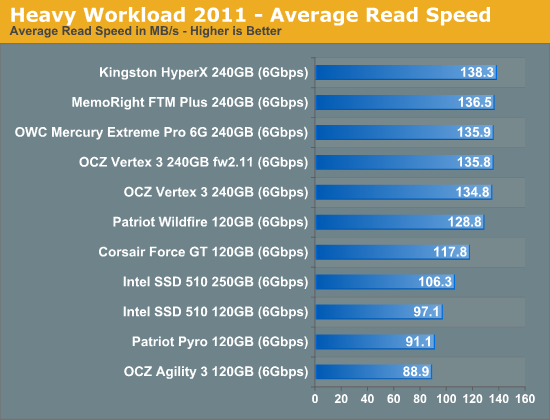
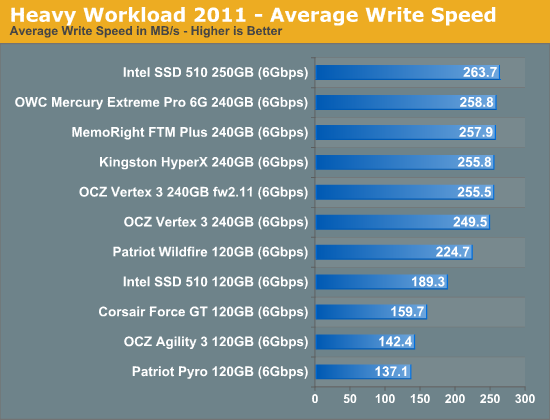
The next three charts just represent the same data, but in a different manner. Instead of looking at average data rate, we're looking at how long the disk was busy for during this entire test. Note that disk busy time excludes any and all idles, this is just how long the SSD was busy doing something:
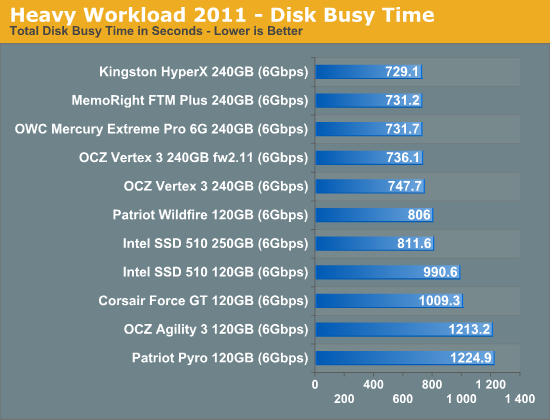
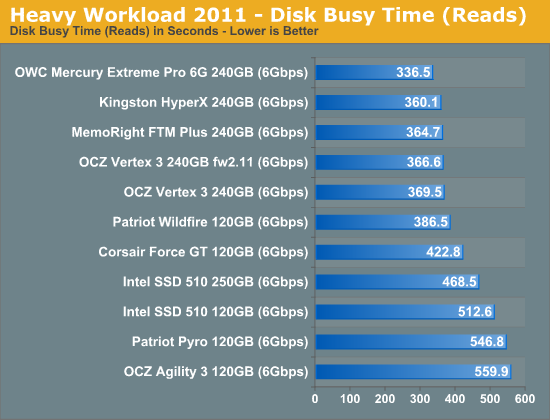
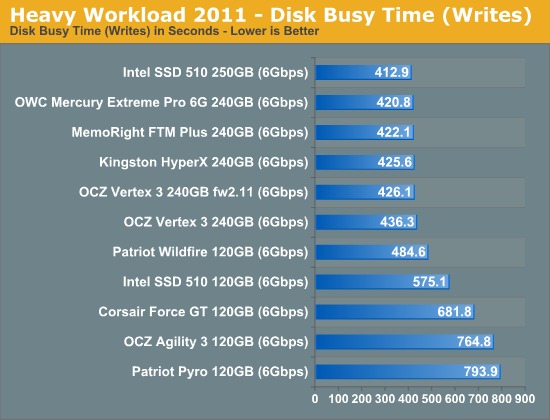










90 Comments
View All Comments
DarkKnight_Y2K - Thursday, August 11, 2011 - link
"Bottom line, it seems like sandforce-driven ssds have the biggest number of issues, yet you still recommend them."Did you read the last sentence of Anand's review?
"The safest route without sacrificing significant performance continues to be Intel's SSD 510."
Socratic - Thursday, August 11, 2011 - link
Yeah I don't know what planet you have been living on, but in MULTIPLE articles Anand has basically ended with the phase, The only logical choice is Intel.How is that being a sandforce fanboy??
You need to keep YOUR bias in line and re-read the article and past articles!!
Anand Lal Shimpi - Thursday, August 11, 2011 - link
Given the continued issues with SF drives I'm quickly looking at other alternatives. Toshiba and Crucial have never been top end performers, which is why I've focused most of my recommendations on the Intel SSD 510. The biggest advantage SandForce continues to have is in better performance over the long run thanks to its live dedupe/compression. I've been working on a way to quantify that for a while unfortunately I don't have a good test I'm happy with...yet.Going forward I believe Samsung may be a bigger player. Take note of the recently announced PM830, expect full coverage of that drive upon its arrival.
http://www.anandtech.com/show/4606/samsung-announc...
Take care,
Anand
melgross - Thursday, August 11, 2011 - link
Well, dedup itself is subject to a lot of controversy. It isn't necessarally a good thing.Anand Lal Shimpi - Thursday, August 11, 2011 - link
I'd argue for most mainstream uses it's a very good thing for long term performance. If the SF-2281 had Intel's track record it'd be the best option in my mind.Take care,
Anand
name99 - Thursday, August 11, 2011 - link
Hi Anand,Rather than beating up on you for not stressing reliability more in the past, I'm going to ask, AGAIN, that you take power more seriously.
My experience has been
- replaced the hard drive in my 2nd gen MacBook Air with a RunCore IV. The thing would crash about once a week, as far as I could tell NOT from logic errors but because its power draw during a long train of writes spiked higher than the interface was specced for. If this coincided with a high power draw elsewhere in the system --- fan, CPU etc, game over
- an OCZ enyo USB3 drive which work just fine as a READ drive --- and is once again somewhat flaky if too many back-to-back writes occur
- a Kingston SSDNow V which I have as the boot/VM drive for my iMac running off USB. My original plan for this was to have it running off FW800 (which is in theory 7W of power), but I got the same thing as the two previous drives --- crashes with too many back to back writes. It's now running successfully because I stuck it in a Kingwin USB<->SATA bridge that is for 3.5" drives, and thus has a separate power supply and the ability to provide a lot of juice.
All this basically mirrors (along a different dimension) what you have said: these drives are ABSOLUTE CRAP for the naive consumer. You buy them, things seem great, and then randomly and with no obvious pattern to the naive user, your system hangs.
You seem to be trying really hard to have the manufacturers get their act together; my point is to remind you that an IMPORTANT part of getting their act together is that these things are ALWAYS within spec with respect to power. Right now, we seem to have a lot (at least three different brands, in three different market segments) of drives that are simply not within spec --- they can run on the power that the system is specced to deliver for most command sequences, but there are always those few command sequences that over-draw power. Heck, at the very least, it is the responsibly of the drive to recognize this
situation and throttle themselves, just like any modern x86 CPU.
Coup27 - Thursday, August 11, 2011 - link
+1.I have been feeling similar sentiments lately as well.
I have posted in the forums on what happened to the 470 review but no official comment from anybody. Considering all of the reliability issues flying about, you woud think that if the 470 was a reliable as word suggests, it would have had a featured review.
Some guy actually bought an Agility 3 based off the AT review and forum list of recommended drives and neither mentioned the BSOD. When he got it the BSOD, he went into the forums and kicked off. Rightly so.
Unfortunately issues drag on for sometimes months before AT even update their article to make people aware that the product they might be buying could be seriously flawed.
No other website offers the depth of detail which AT does and for that the editors are applauded, but unfortunately the playing field does not seem level.
Lord 666 - Thursday, August 11, 2011 - link
Before this article, previous reviews of Vertex problems did not address the issues. This hits it head on.jo-82 - Thursday, August 11, 2011 - link
The Kingston HyperX cleary stands out with a consistent high performance. Why no words on that? Clearly the drive to buy. And Kingston has imho a much higher reputation on circuitry reliance and better QA in general then the rest of the pack, except Intel.Roland00Address - Thursday, August 11, 2011 - link
And I ain't sure you can apply the logic of Kingston being rocking when Kingston purposefully makes their SSD line confusing using similar names with completely different controllersKingston E series, Intel X25-E controller
Kingston M series, Intel X25-M G2 controller
SSDNow V 100, JMicron JMF618 controller
SSDNow V+, Samsung S3C29RBB01 controller
SSDNow V+ 100, Toshiba T6UG1XBG controller
SSDNow V+ 180, Toshiba T6UG1XBG controller
SSDNow V Series, Toshiba TC58NCF602GAT controller, which is based off the stuttering JMicron JMF602
30GB SSDNow V Series Boot Drive, Toshiba T6UG1XBG controller
I may be forgetting to list a couple models, but as I pointed above, Kingston has used 2 different controllers from Intel, 1 from Samsung, and 2 different from Toshiba (and all these controllers have similar names), not counting their most recent drive that is a Sandforce controller.